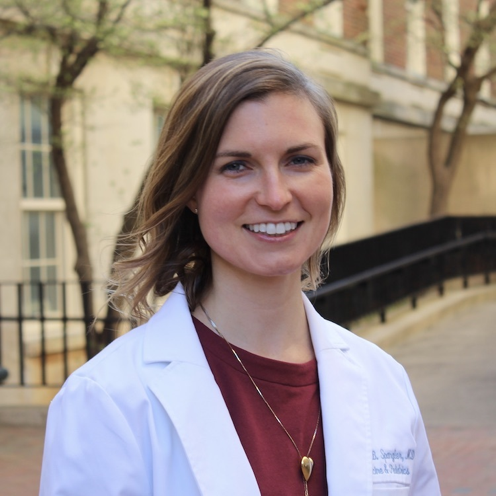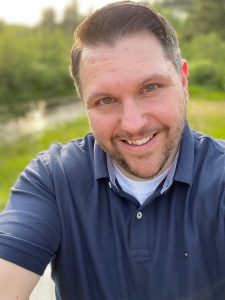Sepsis from Both Sides: Meet the Sepsis Survivors Who Became Care Providers
October 20, 2022

“It’s a full-circle thing,” said Hillary Spangler, MD, a North Carolina-based internal medicine doctor currently doing a fellowship in geriatrics. “When I went to UNC [University of North Carolina Medical Center] as a resident, I ended up training with a lot of the people who took care of me when I was a kid.”
When Dr. Spangler was in the sixth grade, she contracted the flu and developed sepsis, the body’s overwhelming and often life-threatening response to infection. She spent one week in the intensive care unit and three weeks on the children’s ward at the University of North Carolina Medical Center, where she turned 11. She then spent another four months in outpatient rehab, learning to walk again. “My family took me to the only pediatric physical therapy place in a 30-mile radius, multiple times a week,” she reflected. “If I had not had the resources and opportunities to do that, my story could have been completely different.” Fortunately, she made a full recovery, and years later, she would train to be a doctor in the same facility where she was treated for sepsis as a child.
Dr. Spangler is not alone in making a “full-circle” journey from sepsis patient to sepsis care provider. For each of the 1.4 million people in the U.S. who survive sepsis each year, recovery journeys are unique and deeply individual, but some survivors report becoming inspired to begin, refine, or change careers. For this group of individuals, there is often a desire to provide high-quality and compassionate care for others who, like them, have been affected by sepsis.
Jason Kirchick, a nurse in Burlington, Vermont, had a life-threatening experience with sepsis in 2014. After a few days of flu-like symptoms that got progressively worse, he was hospitalized with pneumonia and sepsis. Upon arriving at the hospital, it was determined that three of Jason’s major organ systems were shutting down and a medical team told his family that they weren’t confident he’d last through the night. Fortunately, he did survive the night, but his journey was far from over. Jason spent two months in a medically induced coma, and in the aftermath, he needed to complete six days per week of physical and occupational therapy to regain his strength. It took him a year to recover, and he still struggles with post-sepsis syndrome.

In the years since, Jason has gotten his master’s degree in public health and has become a registered nurse. “There were a few different things going on in my head at the time,” he said of the decision to change his life trajectory. “The first was gratitude – gratitude that I had survived, and that these medical professionals worked so hard to save my life. I wanted to pay it back.”
It wasn’t only gratitude, however, that inspired Jason’s decision. He was also driven by frustration with a healthcare system that cannot always provide a full range of support services for survivors of life-threatening medical conditions like sepsis. “I really wanted to change the bigger picture,” he said. “[Sepsis survivors] may need help navigating the insurance companies, the disability, the resources, the emotional toll, the family toll, the stamina…the looking in the mirror and not recognizing the person staring back. No one prepares you for those things.” With his deeply personal understanding of the complex, long-term, and individualized nature of sepsis recovery, he felt inspired to help the next sepsis survivor to be better prepared, to have their needs more specifically addressed, and to feel, overall, more supported than he did.
“We need providers who understand what separates us [from other survivor populations],” Jason said. “It’s a very different thing when you actually hear what someone has been going through.”
Crystal Waguespack, a utilization review nurse in Gonzales, Louisiana, echoed Jason’s belief that healthcare professionals benefit from understanding the lived experiences of survivors. She, too, had a nearly fatal experience with sepsis. In 2018, she had a ruptured disc that required spinal surgery, after which she developed a post-surgical infection that progressed into sepsis, meningitis, and endocarditis. She was in the hospital for 14 days, but the recovery process was much longer – between extended IV antibiotics and physical therapy, it was a year before some sense of normalcy returned to her life. “It was a lot of stress on the family,” she reflected. “I had small kids at home that needed me that I couldn’t help. My sepsis ordeal led to my divorce. I’m still in pain every now and then.”
The extended and difficult nature of her recovery journey has shaped her approach to her job ever since. Now, she more deeply appreciates the psychological and emotional after-effects of sepsis on survivors. “When you’re in the hospital, providers are treating the infection – there’s really no psychosocial [considerations] involved. But [there can be] a lot of depression, a lot of anxiety, post-sepsis syndrome, PTSD, and all the things that happen after that nobody warns you about,” she said. From her position in utilization review, she finds she can get a more holistic picture of a patient, which helps with anticipating these kinds of emotional needs. “I’m looking at it from the outside in,” she explained. “I’m making sure everybody’s okay when they go home.”
For Crystal and others, being both a survivor and a healthcare professional is not only about providing high-quality medical care. It can also be about helping to advocate for a patient’s needs from the unique vantage point of having been in a similar situation oneself. “I’m passionate about giving patients the tools they need to be able to advocate for themselves and to better prepare them for success,” Jason said. “It’s a big reason why I became a nurse and wanted to get into the medical field: to change the way that patients and families navigate the healthcare system.”
Dr. Spangler shared similar sentiments. “We should be continuing to empower patients and their families – giving them the word ‘sepsis’ to say, giving them signs of when you should come back to the hospital, enabling them to recognize the signs and symptoms,” she said.
When she treats patients on a day-to-day basis, Dr. Spangler’s own sepsis experience is never far from her mind. “The experience really encouraged me to want to be a part of difficult times for families,” she said. “People were there for my family during that horrible time. I am grateful that I have that perspective – I feel like it’s fueled me and guided me in this direction.”
Sepsis Alliance is grateful to the survivors and healthcare professionals who spoke to us for this article. Thank you for sharing your stories and your unique perspectives from both sides of sepsis care!
~
Are you a sepsis survivor, loved one, or caregiver hoping to connect with others about your experience with sepsis? Join Sepsis Alliance Connect, our new virtual support community designed for the millions of people affected by sepsis. Membership is free and open to anybody affected by sepsis!
To learn more about sepsis survivorship, please visit our Sepsis Survivors and Post-Sepsis Syndrome informational webpages.





























